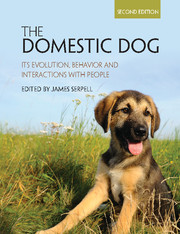Book contents
- Frontmatter
- Dedication
- Contents
- List of contributors
- 1 Introduction
- PART I ORIGINS AND EVOLUTION
- PART II BEHAVIOR, COGNITION AND TRAINING
- 5 Genetics of dog behavior
- 6 Becoming a dog: Early experience and the development of behavior
- 7 Breed and gender differences in dog behavior
- 8 Dog social behavior and communication
- 9 Ethology, ecology and epidemiology of canine aggression
- 10 Social cognition and emotions underlying dog behavior
- 11 The learning dog: A discussion of training methods
- 12 Dogs in today's society: The role of applied animal behavior
- PART III DOG-HUMAN INTERACTIONS
- PART IV LIFE ON THE MARGINS
- Index
- Plate section
- References
5 - Genetics of dog behavior
from PART II - BEHAVIOR, COGNITION AND TRAINING
Published online by Cambridge University Press: 30 December 2016
- Frontmatter
- Dedication
- Contents
- List of contributors
- 1 Introduction
- PART I ORIGINS AND EVOLUTION
- PART II BEHAVIOR, COGNITION AND TRAINING
- 5 Genetics of dog behavior
- 6 Becoming a dog: Early experience and the development of behavior
- 7 Breed and gender differences in dog behavior
- 8 Dog social behavior and communication
- 9 Ethology, ecology and epidemiology of canine aggression
- 10 Social cognition and emotions underlying dog behavior
- 11 The learning dog: A discussion of training methods
- 12 Dogs in today's society: The role of applied animal behavior
- PART III DOG-HUMAN INTERACTIONS
- PART IV LIFE ON THE MARGINS
- Index
- Plate section
- References
Summary
Introduction
Selection for behavior has played a key role in the history of dog domestication and breeding. Early dog domestication probably involved selection for tameness. A few generations of selection for tameness in the famous Russian silver fox experiments led to a domesticated strain of foxes that showed dog-like behavior and displayed curly tails, drop ears, and loss of pigment (Trut et al., 2009). The early domestication of dogs was followed by the formation of dog breeds. Different aspects of ancestral wolf behavior have been selected for in different breeds: dogs have been bred to guard, herd, hunt, pull sleds, and to provide companionship. Selection for physical appearance became more important at a later stage when people began breeding dogs for show. Extreme population bottlenecks, founder effects, drift and strong artificial selection for desired traits during breed formation have resulted in a dog population that is a collection of genetic isolates with highly diverging morphology, disease susceptibility, and behavioral characteristics (Sutter & Ostrander, 2004).
Scott and Fuller (1965) performed a pioneering study of breed differences and inheritance of canine behavior. Their experiment involved dogs of five breeds: basenji, beagle, American cocker spaniel, Shetland sheepdog and wire-haired fox terrier. Breeds and their crosses were compared for reactivity, trainability and problem-solving behaviors. Scott and Fuller observed behavioral differences between the breeds in the majority of their behavioral tests; for instance, in playful aggression and dominance. Wire-haired fox terriers were the most aggressive, consistently “ganging up” on group members. These attacks were so serious that victims had to be removed in order to prevent serious injury. More recently, Svartberg (2006) compared the behavior of 31 dog breeds using data from a standard behavioral test. Significant breed differences were observed for all investigated traits (Figure 5.1). Dog breeds also differ in the prevalence of problem behavior. For instance, certain breeds are predisposed to obsessive-compulsive behaviors: bull terriers frequently exhibit tail chasing, while Doberman pinschers are prone to acral licking.
The fact that breed differences in behavior exist, and that behavioral dispositions can be selected for, suggests that there is a genetic basis for behavior. Behavioral genetics is the study of the individual variation in behavior due to genetic differences between animals. Behavioral genetic studies in dogs have traditionally been studies of breed differences, selection studies, and population-based heritability studies.
- Type
- Chapter
- Information
- The Domestic DogIts Evolution, Behavior and Interactions with People, pp. 69 - 92Publisher: Cambridge University PressPrint publication year: 2016
References
- 1
- Cited by



